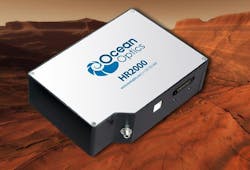Ocean Optics spectrometers on their way to Mars
Dunedin, FL--Three HR2000 high-resolution miniature fiber-optic spectrometers from Ocean Optics began their eight month journey to Mars as part of the ChemCam unit that was launched aboard NASA's Mars Science Lab rover, Curiosity, on November 26, 2011 from Cape Canaveral, FL. The ChemCam instrument is configured to analyze Martian rock and soil using laser induced breakdown spectroscopy (LIBS). A laser mounted to the mast unit of the ChemCam instrument can fire at targets up to 9 m away, generating a series of laser pulses that are collected for LIBS analysis.
Ocean Optics says that the HR2000 spectrometers with their modular design and selectable optical bench options such as detector, grating, and entrance aperture (slit) made them an ideal choice for the LIBS mission. The ChemCam spectrometer is configured to detect elemental signatures over wavelengths of light from 240-336 nm, 380-470 nm, and 470-850 nm. The use of the three spectrometers simplifies the design and creates redundancy, as many elements under study have spectral lines in more than one of the spectral ranges covered by the three units.
The HR2000 was also chosen for its reliability: because the spectrometer contains no moving parts to fail, it can withstand the G forces associated with space travel. In addition, the spectrometers were modified to handle extreme temperature ranges, radiation, shock, and vibration.
The Curiosity Rover has been described by NASA as having the most advanced scientific instrumentation ever used to study the surface of Mars. With the analysis enabled by Ocean Optics’ equipment, sample analysis is exponentially faster. On prior missions, the time required to determine the composition of a single sample was two to three days; ChemCam’s output is anticipated to be one dozen compositional measurements per day.
In 2009, Ocean Optics also collaborated on the ALICE spectrometer, which was instrumental in detecting the presence of water ice on the moon.
SOURCE: Ocean Optics; http://halmapr.com/news/oceanoptics/2011/12/08/ocean-optics-spectrometers-head-to-mars/

Gail Overton | Senior Editor (2004-2020)
Gail has more than 30 years of engineering, marketing, product management, and editorial experience in the photonics and optical communications industry. Before joining the staff at Laser Focus World in 2004, she held many product management and product marketing roles in the fiber-optics industry, most notably at Hughes (El Segundo, CA), GTE Labs (Waltham, MA), Corning (Corning, NY), Photon Kinetics (Beaverton, OR), and Newport Corporation (Irvine, CA). During her marketing career, Gail published articles in WDM Solutions and Sensors magazine and traveled internationally to conduct product and sales training. Gail received her BS degree in physics, with an emphasis in optics, from San Diego State University in San Diego, CA in May 1986.
